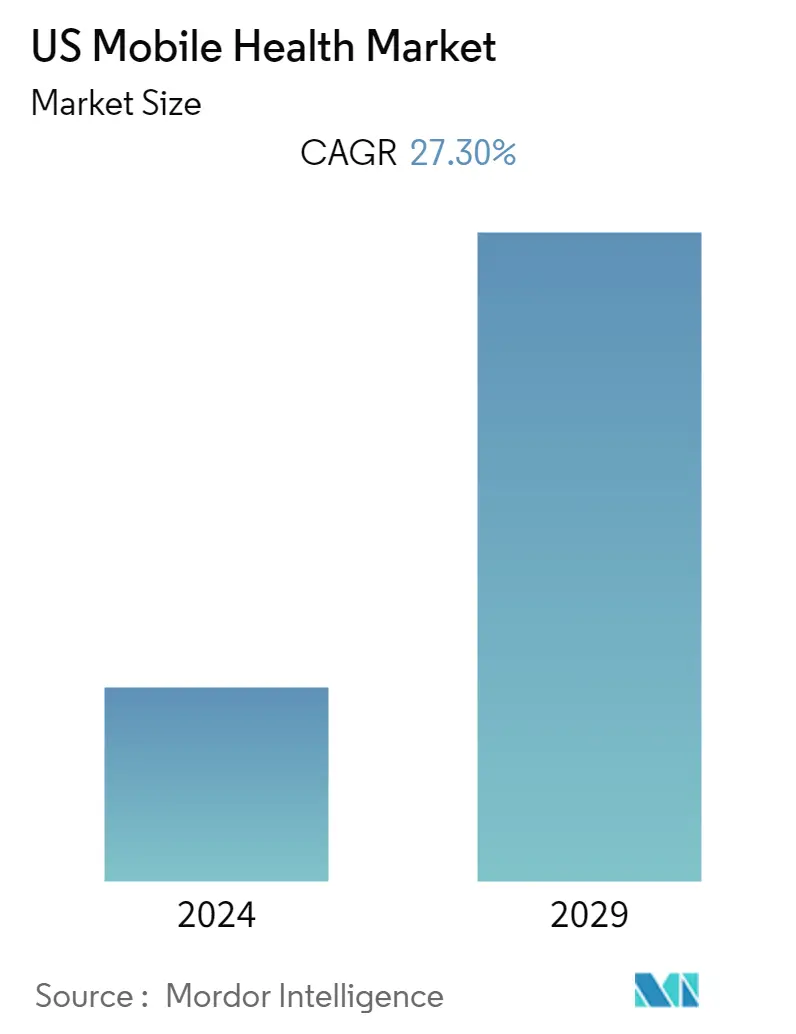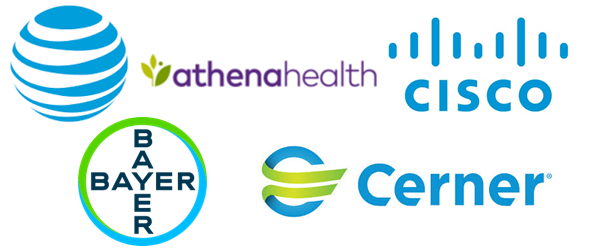Market Size of US Mobile Health Industry

| Study Period | 2019 - 2029 |
| Base Year For Estimation | 2023 |
| Forecast Data Period | 2024 - 2029 |
| Historical Data Period | 2019 - 2022 |
| CAGR | 27.30 % |
Major Players
*Disclaimer: Major Players sorted in no particular order |
US Mobile Health Market Analysis
The key factors propelling the growth of the market is growing usage of smartphones, tablets, and mobile technology in healthcare, increasing awareness for chronic diseases, increased usage of mobile health app, increasing focus on personalized medicine and patient-centric approach is also responsible for the growth of the overall market.
The healthcare market research revolves around the emergence of a new channel, for reaching the respondent that is a mobile smartphone, tablets, and associated mobile technology. The healthcare services and the financials-based services are among the most invested businesses in mobile technology in recent years, with importance given toward the data security and device management. A growing opportunity has been observed in the wireless industry being combined with healthcare. The mobile devices cannot be ignored in the marketing research initiatives, and moreover, it is providing one of the biggest opportunities for quantitative research.
In addition, due to the growing health and fitness awareness, around 90% of consumers download mobile health apps in their smartphones and tablets. This improves the accuracy and consistency with which consumers enter health data into apps. The majority of these types of apps are fitness and wellness apps but also disease management apps, such as blood pressure and blood glucose monitors. Thus, the health market is immensely increasing in the United States, due to the increased adoption of mobile in the healthcare industry.
US Mobile Health Industry Segmentation
As per the scope of the report, the mobile healthcare integrates the healthcare application in mobile technology for healthcare solutions. Mobile health apps and solutions help clinicians to document more accurate and complete records, improve productivity, access information, and communicate findings and treatments. Mobile health apps and solutions also help to improve health outcomes, reduce error rates and maintain low cost. Thus there has been an increasing use of the mobile health app and solutions that increases the adoption of tablets and smart phones.
| By Service Type | |||||
| |||||
| |||||
| |||||
| Wellness and Fitness Solutions | |||||
| Other Service Types (Clinical Decision Making Tools and Others) |
| By Device Type | |
| Blood Glucose Monitors | |
| Cardiac Monitors | |
| Hemodynamic Monitors | |
| Neurological Monitors | |
| Respiratory Monitors | |
| Body and Temperature Monitors | |
| Remote Patient Monitoring Devices | |
| Other Device Types |
| By Stake Holder | |
| Mobile Operators | |
| Healthcare Providers | |
| Application/Content Players | |
| Other Stake Holders |
US Mobile Health Market Size Summary
The US mobile health market is experiencing significant growth driven by the increasing integration of smartphones, tablets, and mobile technology within the healthcare sector. This growth is fueled by heightened awareness of chronic diseases and a rising adoption of mobile health applications, which are pivotal in promoting personalized medicine and a patient-centric approach. The healthcare industry is leveraging mobile technology as a new channel for engagement, with a strong focus on data security and device management. The convergence of wireless technology and healthcare presents substantial opportunities, particularly in quantitative research, as mobile devices become integral to marketing initiatives.
The proliferation of health and fitness awareness has led to widespread consumer adoption of mobile health apps, enhancing the accuracy and consistency of health data entry. These apps encompass a range of functionalities, from fitness and wellness tracking to disease management, such as monitoring blood pressure and glucose levels. The availability of remote patient monitoring devices, supported by wireless technology, is expanding across the country, offering significant benefits for patients with chronic conditions like diabetes and cardiac issues. Major companies are investing in this sector, with key players collaborating with service providers and launching new products to maintain their market presence. This strategic focus is expected to drive substantial revenue growth in the US mobile health market.
US Mobile Health Market Size - Table of Contents
-
1. MARKET DYNAMICS
-
1.1 Market Overview
-
1.2 Market Drivers
-
1.2.1 Growing usage of Smartphones, Tablets, and Mobile Technology in Healthcare
-
1.2.2 Increasing Awareness of People for Chronic Diseases
-
1.2.3 Increasing Focus on Personalized Medicine and Patient-centered Approach
-
1.2.4 Increased Usage of Mobile Health App
-
-
1.3 Market Restraints
-
1.3.1 Data Insecurity
-
1.3.2 Provider Liability Concerns
-
1.3.3 Lower Adoption in Rural Areas
-
-
1.4 Porter's Five Force Analysis
-
1.4.1 Threat of New Entrants
-
1.4.2 Bargaining Power of Buyers/Consumers
-
1.4.3 Bargaining Power of Suppliers
-
1.4.4 Threat of Substitute Products
-
1.4.5 Intensity of Competitive Rivalry
-
-
-
2. MARKET SEGMENTATION
-
2.1 By Service Type
-
2.1.1 Monitoring Services
-
2.1.1.1 Independent Aging Solutions
-
2.1.1.2 Chronic Disease Management
-
2.1.1.3 Post-acute Care Services
-
-
2.1.2 Diagnostic Services
-
2.1.2.1 Self Diagnosis
-
2.1.2.2 Telemedicine Solutions
-
2.1.2.3 Medical Call Centers Manned by Healthcare Professionals
-
-
2.1.3 Treatment Services
-
2.1.3.1 Remote Patient Monitoring Services
-
2.1.3.2 Teleconsultation
-
-
2.1.4 Wellness and Fitness Solutions
-
2.1.5 Other Service Types (Clinical Decision Making Tools and Others)
-
-
2.2 By Device Type
-
2.2.1 Blood Glucose Monitors
-
2.2.2 Cardiac Monitors
-
2.2.3 Hemodynamic Monitors
-
2.2.4 Neurological Monitors
-
2.2.5 Respiratory Monitors
-
2.2.6 Body and Temperature Monitors
-
2.2.7 Remote Patient Monitoring Devices
-
2.2.8 Other Device Types
-
-
2.3 By Stake Holder
-
2.3.1 Mobile Operators
-
2.3.2 Healthcare Providers
-
2.3.3 Application/Content Players
-
2.3.4 Other Stake Holders
-
-
US Mobile Health Market Size FAQs
What is the current US Mobile Health Market size?
The US Mobile Health Market is projected to register a CAGR of 27.30% during the forecast period (2024-2029)
Who are the key players in US Mobile Health Market?
AT&T Inc., Athenahealth Inc., Bayer AG, Cerner Corporation and Cisco Systems Inc. are the major companies operating in the US Mobile Health Market.

